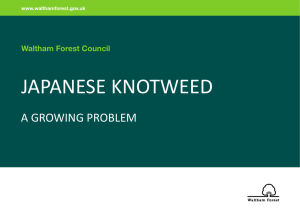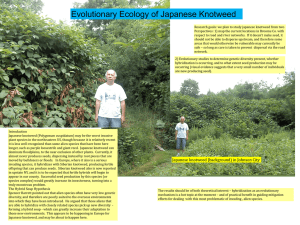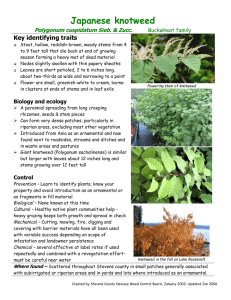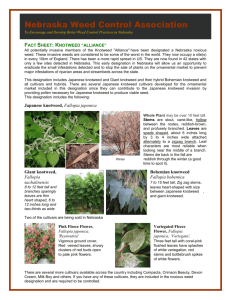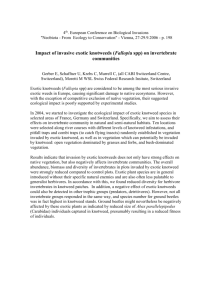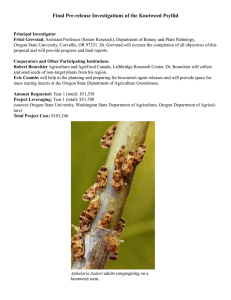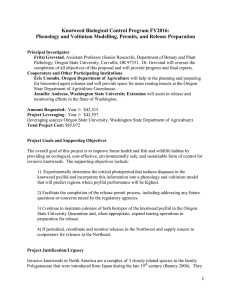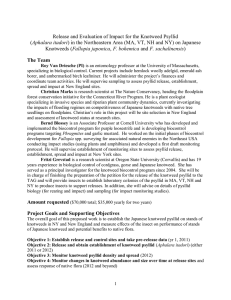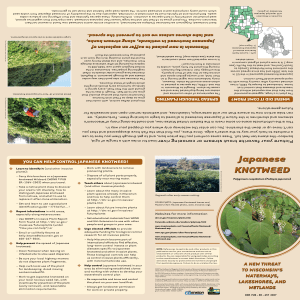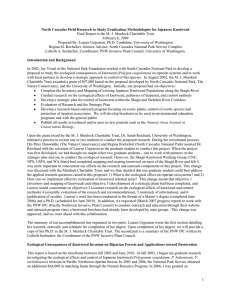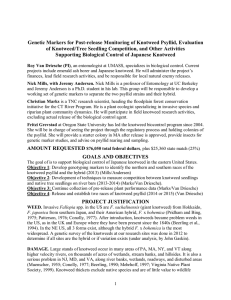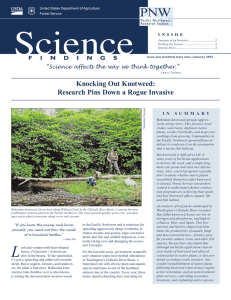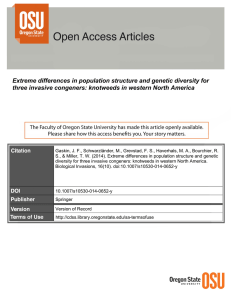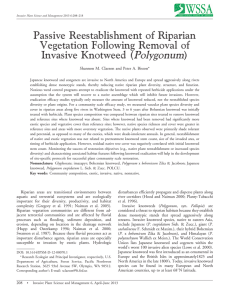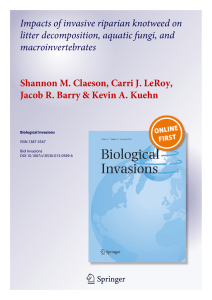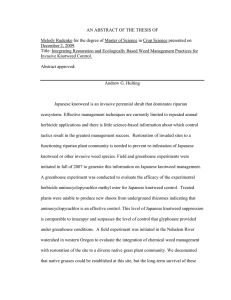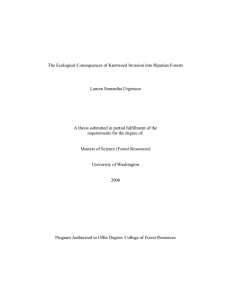Japanese Knotweed Biological Control
advertisement
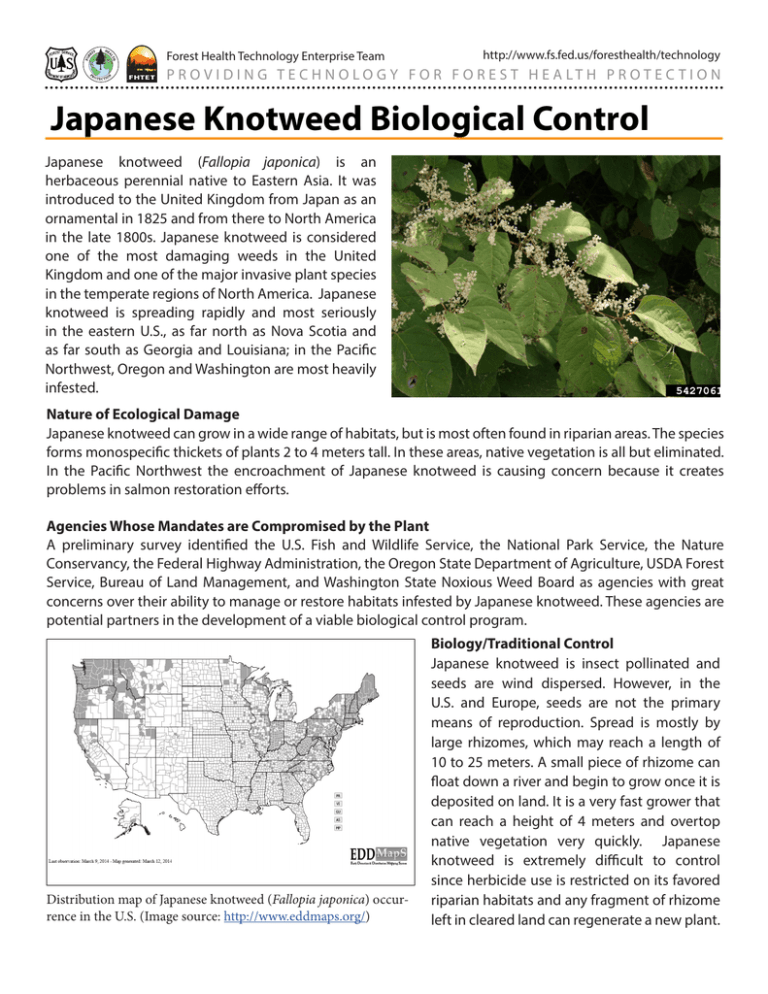
Forest Health Technology Enterprise Team http://www.fs.fed.us/foresthealth/technology P R O V I D I N G T E C H N O L O G Y F O R F O R E S T H E A LT H P R O T E C T I O N Japanese Knotweed Biological Control Japanese knotweed (Fallopia japonica) is an herbaceous perennial native to Eastern Asia. It was introduced to the United Kingdom from Japan as an ornamental in 1825 and from there to North America in the late 1800s. Japanese knotweed is considered one of the most damaging weeds in the United Kingdom and one of the major invasive plant species in the temperate regions of North America. Japanese knotweed is spreading rapidly and most seriously in the eastern U.S., as far north as Nova Scotia and as far south as Georgia and Louisiana; in the Pacific Northwest, Oregon and Washington are most heavily infested. Nature of Ecological Damage Japanese knotweed can grow in a wide range of habitats, but is most often found in riparian areas. The species forms monospecific thickets of plants 2 to 4 meters tall. In these areas, native vegetation is all but eliminated. In the Pacific Northwest the encroachment of Japanese knotweed is causing concern because it creates problems in salmon restoration efforts. Agencies Whose Mandates are Compromised by the Plant A preliminary survey identified the U.S. Fish and Wildlife Service, the National Park Service, the Nature Conservancy, the Federal Highway Administration, the Oregon State Department of Agriculture, USDA Forest Service, Bureau of Land Management, and Washington State Noxious Weed Board as agencies with great concerns over their ability to manage or restore habitats infested by Japanese knotweed. These agencies are potential partners in the development of a viable biological control program. Distribution map of Japanese knotweed (Fallopia japonica) occurrence in the U.S. (Image source: http://www.eddmaps.org/) Biology/Traditional Control Japanese knotweed is insect pollinated and seeds are wind dispersed. However, in the U.S. and Europe, seeds are not the primary means of reproduction. Spread is mostly by large rhizomes, which may reach a length of 10 to 25 meters. A small piece of rhizome can float down a river and begin to grow once it is deposited on land. It is a very fast grower that can reach a height of 4 meters and overtop native vegetation very quickly. Japanese knotweed is extremely difficult to control since herbicide use is restricted on its favored riparian habitats and any fragment of rhizome left in cleared land can regenerate a new plant. Forest Health Technology Enterprise Team http://www.fs.fed.us/foresthealth/technology P R O V I D I N G T E C H N O L O G Y F O R F O R E S T H E A LT H P R O T E C T I O N Overview of Biological Control Program The scientific literature shows a considerable range of natural enemies inflicting damage, in some cases severe, to Asian populations. A classical biological control project was sponsored by the Forest Health Technology Enterprise Team, Cornell University, Commonwealth Agricultural Bureau InternationalBioscience (CABI-Bioscience), Welsh Development Agency, the United Kingdom Environment Agency and various other European and U.S. agencies. This project was the first biological control project against a weed target in the United Kingdom. In 2000, the first year of the multi-year project focused on: (1) the establishment of sites in North America to evaluate ecological impacts and to survey for native natural enemies of the weed, (2) the initiation of overseas investigations. The second year (2001) focused on surveys for natural enemies in Japan, identification of native plants for host specificity tests, and development of a standardized monitoring protocol. The third (2002) and fourth (2003) years focused on overseas exploration, host range testing, ecological impacts, and establishing laboratory colonies of candidate natural enemies in the United States and the United Kingdom. Surveys for F OR M O R E IN FORMAT I ON CO N TAC T: Richard Reardon, Program Manager Biological Control & Biopesticides USDA Forest Service 180 Canfield Street Morgantown, WV 26505 Phone: 304-285-1566 Fax: 304-285-1564 E-mail: rreardon@fs.fed.us existing knotweed natural enemies in North America (conducted in the Northeast, Pacific Northwest, and Alaska) found no herbivores with any potential for control. Damage to Fallopia japonica by foliage-feeding invertebrates and pathogens was high in most of the overseas sites visited by the biocontrol team between 2000 and 2007. Over 186 species of insect herbivores were recorded on F. japonica in Japan along with more than 40 fungal species. From 2004 through 2010, three insects and one pathogen were the focus as potential biological control agents for release in North America: Aphalaris itadori, a sap-sucking psyllid; Ostrinia ovalipennis, a leaf and stem feeding moth; Gallerucida bifasciata, a leaf feeding chrysomelid beetle; and Mycosphaerella sp., a leaf spot pathogen. In 2004, the psyllid, A. itadori, was selected for release in the UK and first releases made in the spring 2010 and again in 2011 and 2012. In 2003-2005, release and control sites were identified in OR and WA and data collected concerning knotweed growth patterns. In 2012, similar release and control sites were identified in MA, VT, and NH. In 2013, the TAG recommended release of A. itadori in the US.
